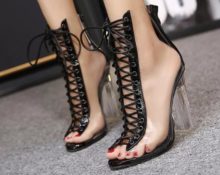The autumn-winter and winter-spring periods, due to weather unpredictability, place quite high demands on the things we wear. Both clothes and shoes must be ready to withstand all the vagaries of the off-season.
Features of the design and material of demi-season shoes
Shoes for each season differ in their characteristics: material and design of the upper, type and structure of the sole, internal “content”. The most popular models for the demi-season:
- boots - the upper covers the back of the foot and covers the ankle;
- ankle boots - clasp the leg to the middle of the calf;
- boots - the top reaches to the knee or higher.
 Solid and pressed, smooth and polished leather, leatherette, polyurethane coating, various synthetic compounds, and rubber are used as uppers for footwear.
Solid and pressed, smooth and polished leather, leatherette, polyurethane coating, various synthetic compounds, and rubber are used as uppers for footwear.
Genuine leather is breathable, strong, durable, warm and comfortable to wear. Pigskin has the highest water resistance rating. It's inexpensive, but rough. Calf is more elastic, soft, easy to process and used for branded models.
Shoe lining provides additional bonuses, such as shape strength, hygiene, thermal insulation, hygroscopicity, and protection of the foot from contact with seams and other external parts. Demi often uses genuine leather, textile or non-woven fabric. The insole should also consist of a hygroscopic material that regulates humidity levels.
The sole is made of genuine leather with a preventive sticker, leatherette, rubber, plastics, PVC, thermoplastic elastomer, polyurethane, and is connected to the base by adhesive, stitching, injection or combinatorial methods.
In what weather can you wear demi shoes?
 At the turn of the seasons, the weather changes at record speed. Average daily temperature fluctuations reach a twenty-degree range: from minus in the early morning to plus at lunchtime. Demi-season shoes are universal, take all this into account, they are designed to be worn in rain, in light frost, and on a warm sunny day. Unfortunately, it is difficult to find a pair that could perfectly match absolutely all weather conditions. So, in damp weather, sealed shoes with thick soles are better used, and in dry weather, you can wear suede ones.
At the turn of the seasons, the weather changes at record speed. Average daily temperature fluctuations reach a twenty-degree range: from minus in the early morning to plus at lunchtime. Demi-season shoes are universal, take all this into account, they are designed to be worn in rain, in light frost, and on a warm sunny day. Unfortunately, it is difficult to find a pair that could perfectly match absolutely all weather conditions. So, in damp weather, sealed shoes with thick soles are better used, and in dry weather, you can wear suede ones.
What temperature can you tolerate comfortably in these shoes?
 The temperature range that demi shoes can withstand can range from -10˚С to +20˚С. It all depends on the material of the upper, sole and lining from which it is made. This information is indicated on the label, it can be checked with the seller or on the manufacturer’s website. But wearing comfort depends not only on temperature, but also on the amount of time we spend outside, on our physical activity.
The temperature range that demi shoes can withstand can range from -10˚С to +20˚С. It all depends on the material of the upper, sole and lining from which it is made. This information is indicated on the label, it can be checked with the seller or on the manufacturer’s website. But wearing comfort depends not only on temperature, but also on the amount of time we spend outside, on our physical activity.
Optimal for long (within reasonable limits) walks – from 0˚С to +10˚С. If the thermometer is negative or there is high humidity (for example, during heavy rain), staying in demi-season shoes for more than one hour will cause discomfort. For those whose work involves long exposure to adverse weather conditions, it is better to choose special equipment.
Is it possible to wear such shoes in winter?
Yes, but only under certain conditions:
- it’s no colder outside -10˚С;
- the sole does not slip;
- the surface is not varnished (it will simply crack);
- in it you only need to walk to warm transport, for example, a car (no more than 5–10 minutes).
A long walk in the cold in such shoes can result in hypothermia or injury.
In the summer?
Temperatures in summer vary; at the beginning of June and at the end of August there is a cold snap, and it often rains. To prevent children from getting their feet wet in a puddle that is difficult to walk past, it is quite acceptable to wear rubber boots without insulation. In the northern regions, it is also logical to get warmer boots or ankle boots to avoid freezing.
Demi shoes for children - when to wear?
 Children's bodies are especially susceptible to colds and viruses. Our great-grandmothers also reasonably reasoned that “all colds come from the feet.” To preserve children's health, their shoe arsenal should include:
Children's bodies are especially susceptible to colds and viruses. Our great-grandmothers also reasonably reasoned that “all colds come from the feet.” To preserve children's health, their shoe arsenal should include:
- boots for dry and warm weather;
- rubber boots for walking in the rain with a special stocking or woolen sock;
- insulated shoes (possible on a bike) for the first autumn or last frosts.
Important! When choosing shoes, especially for children, it is better to give preference to completely natural or multi-layer materials, inside which the foot will “breathe”.
Demi-season shoes should remain presentable, not deteriorate from water and dirt, keeping their owner's feet dry and warm. Therefore, when purchasing, you must be guided by the weather conditions of a particular area, the nature of operation, financial capabilities and concern for your own health.


 0
0




